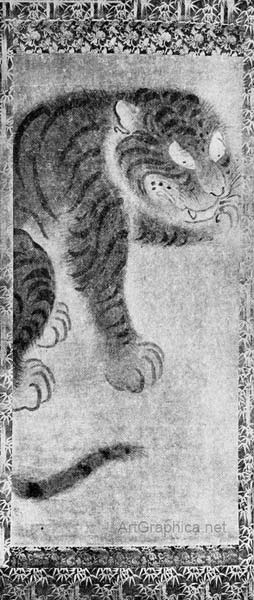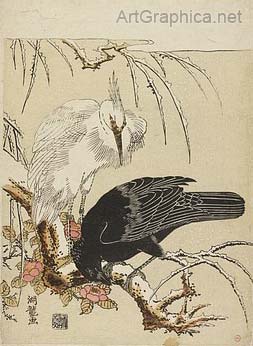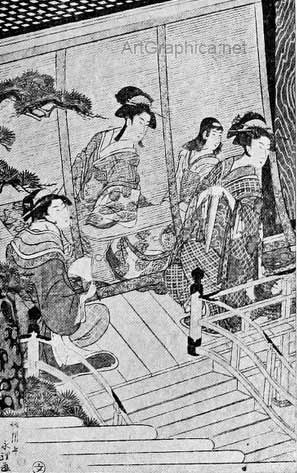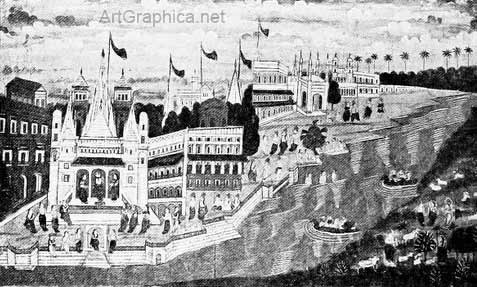Japanese Paintings |
||||||||||||||||
|
Page 22 / 25
 CHAPTER XXINOTES ON THE PERSPECTIVE OF THE JAPANESEA FEW examples of Japanese art will suffice for our purpose of seeing in what manner their observation and rendering of Nature's laws (which we call perspective) coincides or differs from our rendering. Let us select illustrations from " The painters of Japan," by Arthur Morrison. Beginning with the Tosa school, because of its purely national character, we have a masterpiece of drawing in the horses and fighting bulls of Toba Sojo (1053-1140). The perspective foreshortening of their bodies is expressed by overlapping contours in lines that are equally perfect in their decision and subtleness of curves. The drawing shows the animals' passion and power with the fewest possible strokes ; it is naturalistic to a degree, and subject to no convention whatever. At the end of the twelfth century Sumiyoshi Keion, another master of action, depicted the flight of the Imperial Court. A reproduction of a part of his makinmono[1] is given in Mr. Morrison's book. The story of flight and pursuit is irresistibly told. We look on the scene from above, as is so often the case in Japanese works. There is movement in every horse and man ; clothes and horse-tails stream to windward with the pace ; carriages collide ; a horseman jams his hat on his head, another loses his. There is no end of rush and nothing could be added to make a greater stir. There is little of convention here but much art and realism, especially when we remember that light and shade are omitted. The figures near-to have space of ground between them, and appear densely packed further away, after the manner of every crowd. The bow-men sit their galloping steeds as our own huntsmen do. The carriages are foreshortened just as we should draw them now. But how can we explain the wheels ? Their axles run true with the body, and the long pointed hubs stand out at the correct angle. One carriage being foreshortened runs on elliptical wheels as is right that it should, but others seen almost side view have wheels that are hardly more round. Was there some convention in the twelfth century persuading this great realist and accurate observer of Nature to make a wheel oval in shape instead of a circle ? 1 The original is in the Boston Museum. And now take note of this when you talk of modern impressionism. The ox drawing the central carriage has been pulled up sharp, to clear itself of another galloping past his head, so every spoke in the stationary wheel is drawn easy to see. The other carriage travels so fast that the rotating spokes are invisible, and so are represented by countless circular lines ; lines that in those days as now, were equally expressive of the presence of the spokes and their blurred movement. Passing on to the seventeenth century to Tosa Mitsuoki in his portrait of a saint writing at a table, we see a good instance of spaces as they recede being represented wider, instead of the side boundaries becoming narrower in the distance as our perspective teaches us. The far end of the table is drawn the same height as the near end, and to our eyes accustomed to heights appearing shorter as they are more distant, it appears even to be taller. However, as if to confuse us should we have theories to account for this manner of drawing, we see that the saint holds in his hand a half-rolled paper whose sides recede in the way we ourselves would draw them. Leaving the Tosa school for that of the Chinese renaissance of the fourteenth century we find many masterpieces of landscape, birds, and animals that are useful for our enquiry. One and all they show a delight in the foreshortening of curved lines. There is a white falcon painted by Oguri Sotan (fifteenth century) with the rows of the feathers beautifully expressing the modelling of the bird. The perch he sits on has an encircling band, the edges of which might be examples of a foreshortened circle. The stripes on Noami's ideal tiger (Illus. LXXVII) construct the animal. Each stroke gives the rounding or a foreshortened surface of its body. Surely the perspective of curved lines was never put to so great a trial before ! The painter knowing their possibilities and his own power, used them in place of an outline ; and in short, has juggled with them where a lesser man would not even have known their significance. The details of Nature have always been so perfectly and naturally represented by the Japanese of all schools, that there is no need to call attention to the fact. All good drawings of dress by the Japanese show an intuitive selection of those folds that suggest the figure. The rounding of a shoulder, or the foreshortening of a side, is habitually given by a delicate but unerring line. It is the same appreciation of truth and beauty that we see in fine work of other nations. The portrait of a Chinese poet riding by Unkoku Togan will prove it to you. JAPANESE COLOUR PRINTS The aim of the Ukioye school, the designers of colour-prints td provide art for the people, is exactly expressed by E. F. Strange's translation of " Ukiyo-Ye " as " mirror of the passing world." Fortunately we have in this country many faces of this mirror for our study and delight. Hishigawa Moronobu was born in 1625, forty-seven years after the birth of Matabei, the founder of the school. There is a very delightful painting of dancers and musicians by him reproduced in Morrison's book. The joyous figures, full of animation and grace, dance round the old musician, who sedately pipes to them unconscious of the fact that he is sitting just off the edge of the carpeted platform, or that its top provides a violently sloping seat for the girl musicians behind him. A print by Kiyonobu (1664-1729) in the British Museum shows the rendering, usual at his time, of receding edges of boxes, screens, etc., that would be parallel in Nature, represented by parallel lines in the picture. One of Koriusai's prints of a " Crow and the Heron," (Illus LXXVIII), in the National Art Library, shows how well the solidity of the form can be shown by single lines that follow its modelling. Here the same lines draw the feathers and the contours of the birds. It is a beautiful example of the national appreciation of the perspective of curved lines. A drawing by Shiba Kokan (1747-1818), in Mr. Morrison's collection, represents a labourer with a distant landscape, notable for its low horizon in contrast to the very high point of view usually selected by the Japanese ; in fact, a very usual custom of these early masters was to remove the roof of a house so that its interior arrangements could be better displayed. We have something nearly corresponding to this device in Dutch and English paintings of cottage rooms, where a wall must have been missing to allow of the view ; the arrangement was also adopted in the early European prints. Katsugawa Shunsho (1726-1792) had the same habit of drawing surfaces as they recede remaining the same size or even getting larger. We see innumerable examples throughout their schools of a right-angled object—a box, for instance, with one corner towards us—being represented by parallel lines for the receding edges of its sides and top, as the object really has, but not as they appear. On the other hand, the meeting of the sides will be drawn not as a right angle (as in Nature) but as an obtuse one, like we should make it.[1] 1 This closely resembles a deplorable modern manner of depicting objeets. It is called isometric drawing. All lines that recede are drawn parallel to one another so that a box is represented the same height and width at the near and far end, but the corners instead of being right angles are drawn at 30° angle with the horizon.
There is a print in South Kensington by Yeiri, " The house of a noble, with ladies looking through a screen." A staircase leads up to the balcony where the ladies sit. The boards are laid at right angles to the stairs (Illus. LXXIX). We have just spoken of a similar treatment of similar lines, and the effect in this picture is curious. One does not easily forget the " Arrest of Marubishi Chuya," a print in South Kensington by Toyoharu. One would like to talk about the raving captive, but his cage only concerns us. It is an open framework of timber seen from above. The top and front surfaces of the receding rails remain parallel to one another where we should draw them converging to a distant vanishing point. The upright posts are equidistant, and of the same width, consequently the spaces between them are alike, both in shape and size. One comes to the conclusion that their accuracy of eye enabled them to draw curves and angles without hesitation, and that some convention compelled them to represent receding surfaces as they really are, but not as they saw them.
Knowing their power of foreshortening an arm, a foot, a branch or a dicky-bird's head, one cannot believe that such observers of Nature, and masters of drawing, could find a difficulty in following the lines of parallel-sided objects. The Indian drawing reproduced inlus LXXX showed that the greatest care had been bestowed upon it. It is a good example of unruly perspective.
Next Page
Architects Perspective Prev Page Use of Perspective in Art
|
||||||||||||||||












